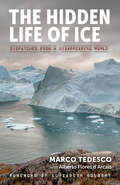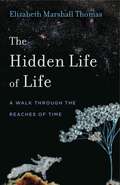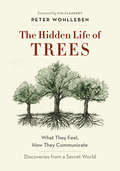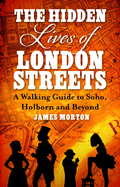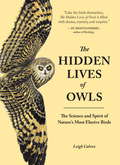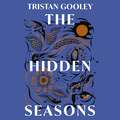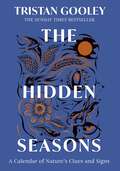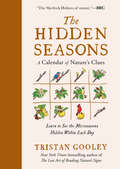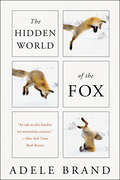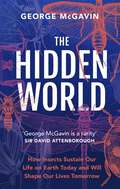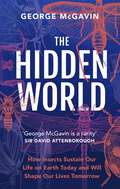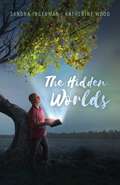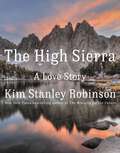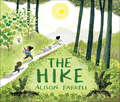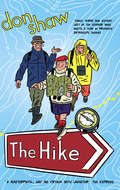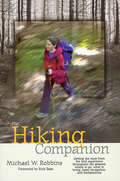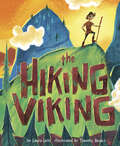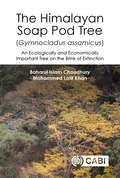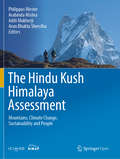- Table View
- List View
The Hidden Life of Ice: Dispatches From A Disappearing World
by Marco Tedesco Alberto Flores d'ArcaisFor most of us, the Arctic is a vast, alien landscape; for research scientist Marco Tedesco, it is his laboratory, his life’s work—and the most beautiful, most endangered place on Earth. Marco Tedesco is a world-leading expert on Arctic ice decline and climate change. In The Hidden Life of Ice, he invites us to Greenland, where he and his fellow scientists are doggedly researching the dramatic changes afoot. Following the arc of his typical day in the field, he unearths the surprising secrets just beneath the icy surface—from evidence of long-extinct “polar camels” to the fantastically weird microorganisms that live in freezing cryoconite holes—as well as critical clues about the future of our planet. Not just a student of its secrets, Tedesco is an acolyte of the Arctic’s beauty—its “magnificence and fragility,” as Elizabeth Kolbert writes in her foreword. Alongside the sobering facts on climate change, Tedesco shares stunning photographs of this surreal landscape— as well as captivating legends of Greenland’s earliest local populations, epic deeds of long-ago Arctic explorers, and his own moving reflections. This is an urgent tribute to an awe-inspiring place that may be gone all too soon.
The Hidden Life of Life: A Walk through the Reaches of Time (Animalibus)
by Elizabeth Marshall ThomasAn iconoclast and best-selling author of both nonfiction and fiction, Elizabeth Marshall Thomas has spent a lifetime observing, thinking, and writing about the cultures of animals such as lions, wolves, dogs, deer, and humans. In this compulsively readable book, she provides a plainspoken, big-picture look at the commonality of life on our planet, from the littlest microbes to the largest lizards.Inspired by the idea of symbiosis in evolution—that all living things evolve in a series of cooperative relationships—Thomas takes readers on a journey through the progression of life. Along the way she shares the universal likenesses, experiences, and environments of “Gaia’s creatures,” from amoebas in plant soil to the pets we love, from proud primates to Homo sapiens hunter-gatherers on the African savanna. Fervently rejecting “anthropodenial,” the notion that nonhuman life does not share characteristics with humans, Thomas instead shows that paramecia can learn, plants can communicate, humans aren’t really as special as we think we are—and that it doesn’t take a scientist to marvel at the smallest inhabitants of the natural world and their connections to all living things.A unique voice on anthropology and animal behavior, Thomas challenges scientific convention and the jargon that prevents us all from understanding all living things better. This joyfully written book is a fascinating look at the challenges and behaviors shared by creatures from bacteria to larvae to parasitic fungi, a potted hyacinth to the author herself, and all those in between.
The Hidden Life of Life: A Walk through the Reaches of Time (Animalibus: Of Animals and Cultures #13)
by Elizabeth Marshall ThomasAn iconoclast and best-selling author of both nonfiction and fiction, Elizabeth Marshall Thomas has spent a lifetime observing, thinking, and writing about the cultures of animals such as lions, wolves, dogs, deer, and humans. In this compulsively readable book, she provides a plainspoken, big-picture look at the commonality of life on our planet, from the littlest microbes to the largest lizards.Inspired by the idea of symbiosis in evolution—that all living things evolve in a series of cooperative relationships—Thomas takes readers on a journey through the progression of life. Along the way she shares the universal likenesses, experiences, and environments of “Gaia’s creatures,” from amoebas in plant soil to the pets we love, from proud primates to Homo sapiens hunter-gatherers on the African savanna. Fervently rejecting “anthropodenial,” the notion that nonhuman life does not share characteristics with humans, Thomas instead shows that paramecia can learn, plants can communicate, humans aren’t really as special as we think we are—and that it doesn’t take a scientist to marvel at the smallest inhabitants of the natural world and their connections to all living things.A unique voice on anthropology and animal behavior, Thomas challenges scientific convention and the jargon that prevents us all from understanding all living things better. This joyfully written book is a fascinating look at the challenges and behaviors shared by creatures from bacteria to larvae to parasitic fungi, a potted hyacinth to the author herself, and all those in between.
The Hidden Life of Trees: What They Feel, How They Communicate --Discoveries from a Secret World
by Tim Flannery Peter Wohlleben<P>In The Hidden Life of Trees, Peter Wohlleben shares his deep love of woods and forests and explains the amazing processes of life, death, and regeneration he has observed in the woodland and the amazing scientific processes behind the wonders of which we are blissfully unaware. Much like human families, tree parents live together with their children, communicate with them, and support them as they grow, sharing nutrients with those who are sick or struggling and creating an ecosystem that mitigates the impact of extremes of heat and cold for the whole group. As a result of such interactions, trees in a family or community are protected and can live to be very old. In contrast, solitary trees, like street kids, have a tough time of it and in most cases die much earlier than those in a group.<P><P> Drawing on groundbreaking new discoveries, Wohlleben presents the science behind the secret and previously unknown life of trees and their communication abilities; he describes how these discoveries have informed his own practices in the forest around him. As he says, a happy forest is a healthy forest, and he believes that eco-friendly practices not only are economically sustainable but also benefit the health of our planet and the mental and physical health of all who live on Earth. <P><b>A New York Times Bestseller</b>
The Hidden Lives of London Streets: A Walking Guide to Soho, Holborn and Beyond
by James MortonLondon's streets have always worn a variety of influences, reflecting the diverse crowds who live and work on them. Take a walk down any number of historic streets and an abundance of tales exist in the bricks and mortar, waiting to be told. The Hidden Lives of London's Streets takes the reader on a journey through Soho, Piccadilly, Mayfair, Knightsbridge, Chelsea, Kensington, Fitzrovia and Clerkenwell. A street map is provided for each area, marking out the streets and buildings in which the various activities - some forgotten, others well-remembered - took place.Stories include those of courtesans such as the notorious Lola Montez and Theresa de Cornelys, who gave lavish balls at their home in Soho Square which were little more than orgies, during which a man playing the violin while on roller skates crashed through her plate glass window; Casanova and his quarrel with Marianne Charpillon after he taught a parrot to say she was a 'whore'; clubs - great (the Gargoyle), the artistic (Muriel Belcher's Colony), and the small (Royston Smith's club for dwarves); the police; robberies; murder and executions; the nightclubs; cinemas and theatres; the villains and prostitution. Beyond mere gangs and criminality, the book will trace the social changes that have gradually unfolded on any given street. For example the metamorphosis of Old Compton Street as home to race gangs in the 1920s, to becoming an essentially Italian street, to being part of the gay community.
The Hidden Lives of Owls: The Science and Spirit of Nature's Most Elusive Birds
by Leigh CalvezA naturalist probes the forest, mainly at night, to comprehend the secret lives of owls in this book that will appeal to readers of Crow Planet and H is for Hawk. Join Leigh Calvez on adventures into the world of owls: owl-watching, avian science, and the deep forest--often in the dead of night. These birds are a bit mysterious, and that's part of what makes them so fascinating. Calvez makes the science entertaining and accessible while exploring the questions about the human-animal connection, owl obsession, habitat, owl calls, social behavior, and mythology.From the Trade Paperback edition.
The Hidden Seasons
by Tristan Gooley'When we know what to look for and what it means, seasonal moments that were once hiddenshine brightly.'In The Hidden Seasons, Tristan Gooley shows us how to read the clues that the sun, moon, stars, plants, fungi, animals, water and weather give us - but that we continually miss, because we don't know how and where to look.Spring is the time of wildflower signs, unique cloud shapes and curious animal behaviour. Summer is a time of coastal clues, astronomical extremes and secret grass patterns. Autumn is a time for reading leaves, deciphering scents and investigating fungi. And in winter, we learn to read snow, deepen our star knowledge and use rare methods to find clues in overlooked places, including indoors.As with Tristan Gooley's bestsellers The Walker's Guide, How to Read Water and How to Read a Tree, The Hidden Seasons inspires us to explore these signs for ourselves, giving us many rich insights into our turning year. Soon we will be able to anticipate and celebrate daily changes that few notice, however surprising they may be.And the seasons will never look, sound or smell the same again.
The Hidden Seasons
by Tristan Gooley'When we know what to look for and what it means, seasonal moments that were once hiddenshine brightly.'In The Hidden Seasons, Tristan Gooley shows us how to read the clues that the sun, moon, stars, plants, fungi, animals, water and weather give us - but that we continually miss, because we don't know how and where to look.Spring is the time of wildflower signs, unique cloud shapes and curious animal behaviour. Summer is a time of coastal clues, astronomical extremes and secret grass patterns. Autumn is a time for reading leaves, deciphering scents and investigating fungi. And in winter, we learn to read snow, deepen our star knowledge and use rare methods to find clues in overlooked places, including indoors.As with Tristan Gooley's bestsellers The Walker's Guide, How to Read Water and How to Read a Tree, The Hidden Seasons inspires us to explore these signs for ourselves, giving us many rich insights into our turning year. Soon we will be able to anticipate and celebrate daily changes that few notice, however surprising they may be.And the seasons will never look, sound or smell the same again.
The Hidden Seasons: A Calendar of Nature's Clues (Natural Navigation)
by Tristan Gooley"The Sherlock Holmes of Nature"?BBC From the New York Times–bestselling author of The Lost Art of Reading Nature's Signs: Learn to spot the endlessly unfolding clues and signs that reveal the hidden ways nature changes every day of the year "Gooley preaches attention to common patterns in nature like a sommelier describing wine—the shadows cast by the sun here, the tree angled there, the moss greener on this side of the rock."—The New York Times We all notice the flowers of spring, longer days of summer, colors of autumn, and snowfalls of winter. But have you observed the way that water tends to run clearest in June? Did you know that at the stroke of midnight on New Year’s Eve, you can find Sirius due south in the night sky? And have you seen the poetic "shadow compasses" butterflies make on the hottest days, as they align their wings with the sun, their thin shadows pointing the way north? The sun, moon, stars, plants, fungi, animals, water, and weather all tell us secrets about the seasons—if we know how to read their clues. In this sense-awakening book, New York Times–bestselling author Tristan Gooley reimagines the seasonal calendar not as four distinct phases but as a series of changes evolving moment by moment every day of the year. Each granular shift is an extraordinary microseason you won’t want to miss. It’s time to get out there and explore—the seasons will never look, sound, or smell the same again.
The Hidden Universe: Adventures in Biodiversity
by Alexandre AntonelliAn unforgettable exploration of the natural world and the concept of biodiversity—what it is, why it matters, and how we as individuals can work to preserve it. We are now living in an environmental emergency. As climate change, habitat loss, and other threats have placed almost one-fifth of all species on Earth at risk of extinction in the coming decades, a deeper understanding of biodiversity has never been more important. Biodiversity encompasses the rich variety of all life on Earth—the building blocks of life that provide invaluable sources of food, medicine, clothing, building materials, and more. Marking the arrival of a bold new voice in popular science, The Hidden Universe shows readers what’s at stake in the fight to protect and restore biodiversity, but also what can and should be done now to protect our planet and ourselves for the future. As director of science at one of the world’s largest research organizations in plant and fungal sciences, Brazilian-born scientist Alexandre Antonelli is ideally suited to reveal the wonders of biodiversity at a genetic, species, and ecosystem level—what biodiversity is, how it works, and why it is the most important tool in our battle against climate change. Antonelli offers recommendations for large-scale political changes, as well as smaller, practical steps that readers can implement in their own lives and homes. With Antonelli as our guide, The Hidden Universe helps us imagine a future where biodiversity is not just preserved but cherished.
The Hidden Universe: Adventures in Biodiversity
by Alexandre AntonelliAn unforgettable exploration of the natural world and the concept of biodiversity—what it is, why it matters, and how we as individuals can work to preserve it. We are now living in an environmental emergency. As climate change, habitat loss, and other threats have placed almost one-fifth of all species on Earth at risk of extinction in the coming decades, a deeper understanding of biodiversity has never been more important. Biodiversity encompasses the rich variety of all life on Earth—the building blocks of life that provide invaluable sources of food, medicine, clothing, building materials, and more. Marking the arrival of a bold new voice in popular science, The Hidden Universe shows readers what’s at stake in the fight to protect and restore biodiversity, but also what can and should be done now to protect our planet and ourselves for the future. As director of science at one of the world’s largest research organizations in plant and fungal sciences, Brazilian-born scientist Alexandre Antonelli is ideally suited to reveal the wonders of biodiversity at a genetic, species, and ecosystem level—what biodiversity is, how it works, and why it is the most important tool in our battle against climate change. Antonelli offers recommendations for large-scale political changes, as well as smaller, practical steps that readers can implement in their own lives and homes. With Antonelli as our guide, The Hidden Universe helps us imagine a future where biodiversity is not just preserved but cherished.
The Hidden World of the Fox
by Adele BrandA mammal ecologist’s “ode to this familiar yet mysterious creature . . . by turns lyrical, salty, funny and scholarly” (The New York Times Book Review).The fox. For thousands of years myth and folklore have celebrated its cunning intelligence. Today the red fox is the nature’s most populous carnivore, its dancing orange tail a common sight in backyards. Yet who is this wild neighbor, truly? How do we negotiate this uneasy new chapter of an ancient relationship? Join British ecologist Adele Brand on a journey to discover the surprising secrets of the fabled fox, the enigmatic creature that has adapted to the human world with astonishing—some say, unsettling—success.Brand has studied foxes for twenty years across four continents—from the Yucatán rainforest to India’s remote Thar Desert, from subarctic Canada to metropolitan London. Her observations have convinced her that the fox is arguably the most modern of all wildlife, uniquely suited to survival in the rapidly expanding urban/wild interface. Blending cutting-edge science, cultural anthropology, and intimate personal storytelling drawn from her own remarkable fieldwork, The Hidden World of the Fox is Brand’s rich and revelatory portrait of the extraordinary animal she has devoted her life to understanding.“A spirited look at the red fox . . . Thanks to her mix of biology, personal history, and pop culture, Brand’s readers will be left both entertained and better informed about ‘this small, curious member of the dog family.’”—Publishers Weekly
The Hidden World: How Insects Sustain Life on Earth Today and Will Shape Our Lives Tomorrow
by George McGavinInsects conquered the Earth long before we did and will remain here long after we’re gone.They outnumber us in the billions and are essential to many of the natural processes that keep us alive and that we take for granted.Yet, despite this, very few of us know much about the hidden world of insects.In this fascinating new book, entomologist and broadcaster George McGavin takes a deep dive to reveal the unknown truths about the most successful and enduring animal group the world has ever seen, and to show the unseen effects this vast population has on our planet, if only we care to look.McGavin explores not only the incredible traits that insects have evolved to possess, such as dragonflies that can fly across oceans without resting or beetles that lay their eggs exclusively in corpses, but also the vital lessons we have learnt from them, including how therapy using maggots can save lives and how bees can help grow rich tomato yields. The Hidden World reveals the wonderful complexity of our relationship with insects, how they have changed the course of our history and how, if we continue to learn from them, they could even be the key to our future and survival.
The Hidden World: How Insects Sustain Life on Earth Today and Will Shape Our Lives Tomorrow
by George McGavinInsects conquered the Earth long before we did and will remain here long after we’re gone.They outnumber us in the billions and are essential to many of the natural processes that keep us alive and that we take for granted.Yet, despite this, very few of us know much about the hidden world of insects.In this fascinating new book, entomologist and broadcaster George McGavin takes a deep dive to reveal the unknown truths about the most successful and enduring animal group the world has ever seen, and to show the unseen effects this vast population has on our planet, if only we care to look.McGavin explores not only the incredible traits that insects have evolved to possess, such as dragonflies that can fly across oceans without resting or beetles that lay their eggs exclusively in corpses, but also the vital lessons we have learnt from them, including how therapy using maggots can save lives and how bees can help grow rich tomato yields. The Hidden World reveals the wonderful complexity of our relationship with insects, how they have changed the course of our history and how, if we continue to learn from them, they could even be the key to our future and survival.
The Hidden World: How Insects Sustain Life on Earth Today and Will Shape Our Lives Tomorrow
by George McGavinInsects conquered the Earth long before we did and will remain here long after we're gone.They outnumber us in the billions and are essential to many of the natural processes that keep us alive and that we take for granted.Yet, despite this, very few of us know much about the hidden world of insects.In this fascinating new book, entomologist and broadcaster George McGavin takes a deep dive to reveal the unknown truths about the most successful and enduring animal group the world has ever seen, and to show the unseen effects this vast population has on our planet, if only we care to look.McGavin explores not only the incredible traits that insects have evolved to possess, such as dragonflies that can fly across oceans without resting or beetles that lay their eggs exclusively in corpses, but also the vital lessons we have learnt from them, including how therapy using maggots can save lives and how bees can help grow rich tomato yields.The Hidden World reveals the wonderful complexity of our relationship with insects, how they have changed the course of our history and how, if we continue to learn from them, they could even be the key to our future and survival.
The Hidden Worlds
by Sandra Ingerman Katherine WoodWere those people in Isaiah's dream the same people from school? Popular soccer star Magda? George, who he'd never heard speak because he always left classes for special services help? Angry Rose, the Chinese girl who was always in trouble for fighting? And why were there dead birds and fish everywhere? When the four encounter one another the next day by the same pond from the dream, they realize they've shared a dream and there really are dead birds and fish covering the ground! This leads to real-life adventures and more dreams as they discover a toxic waste plant disposing of poisons illegally. Not friends in the beginning, romance blossoms as they work together with their Power Animals to close down the plant.
The High Seas: Ambition, Power and Greed on the Unclaimed Ocean
by Olive Heffernan'A vital, fascinating, deeply researched exploration of Earth's last wilderness...Shocking and starkly illuminating - a must-read.' Gaia VinceThe ocean covers seventy per cent of the surface of our planet, and two thirds of this lie beyond national borders. Owned by all nations and no nation simultaneously, these waters are home to some of the richest and most biodiverse environments on the planet. But they are also home to exploitation on a scale that few of us can imagine.Here, industry and economic progress rule and lax enforcement and apathy are the status quo. Out of sight and often out of mind, a battle rages to control, profit from, protect, or obliterate the world's largest, wildest commons. Heffernan sets sail on a journey to uncover the truth behind deeply exploitative fishing practices, investigate the potentially devastating impact of deep-sea mining, and hold to task the Silicon-valley interventionists whose solutions to climate change are often wildly optimistic, radically irresponsible or both.The result is a forceful and deeply researched manifesto calling for the protection and preservation of this final frontier - the last vestiges of wilderness on Earth.
The High Sierra: A Love Story
by Kim Stanley RobinsonA &“sublime&” and &“radically original&” exploration of the Sierra Nevadas, the best mountains on Earth for hiking and camping, from New York Times bestselling novelist Kim Stanley Robinson (Bill McKibben, Gary Snyder). Kim Stanley Robinson first ventured into the Sierra Nevada mountains during the summer of 1973. He returned from that encounter a changed man, awed by a landscape that made him feel as if he were simultaneously strolling through an art museum and scrambling on a jungle gym like an energized child. He has returned to the mountains throughout his life—more than a hundred trips—and has gathered a vast store of knowledge about them. The High Sierra is his lavish celebration of this exceptional place and an exploration of what makes this span of mountains one of the most compelling places on Earth.Over the course of a vivid and dramatic narrative, Robinson describes the geological forces that shaped the Sierras and the history of its exploration, going back to the indigenous peoples who made it home and whose traces can still be found today. He celebrates the people whose ideas and actions protected the High Sierra for future generations. He describes uniquely beautiful hikes and the trails to be avoided. Robinson&’s own life-altering events, defining relationships, and unforgettable adventures form the narrative&’s spine. And he illuminates the human communion with the wild and with the sublime, including the personal growth that only seems to come from time spent outdoors.The High Sierra is a gorgeous, absorbing immersion in a place, born out of a desire to understand and share one of the greatest rapture-inducing experiences our planet offers. Packed with maps, gear advice, more than 100 breathtaking photos, and much more, it will inspire veteran hikers, casual walkers, and travel readers to prepare for a magnificent adventure.
The High-Mountain Cryosphere
by John J. Clague Huggel, Christian and Carey, Mark and Clague, John J. and Kääb, Andreas Christian Huggel Mark Carey Andreas KääbThis edited volume, showcasing cutting-edge research, addresses two primary questions - what are the main drivers of change in high-mountains and what are the risks implied by these changes? From a physical perspective, it examines the complex interplay between climate and the high-mountain cryosphere, with further chapters covering tectonics, volcano-ice interactions, hydrology, slope stability, erosion, ecosystems, and glacier- and snow-related hazards. Societal dimensions, both global and local, of high-mountain cryospheric change are also explored. The book offers unique perspectives on high-mountain cultures, livelihoods, governance and natural resources management, focusing on how global change influences societies and how people respond to climate-induced cryospheric changes. An invaluable reference for researchers and professionals in cryospheric science, geomorphology, climatology, environmental studies and human geography, this volume will also be of interest to practitioners working in global change and risk, including NGOs and policy advisors.
The Hike
by Alison Farrell&“These young explorers demonstrate the best principles of time spent in the woods: observing, admiring and learning . . . Delightfully illustrated.&” —The New York Times With lyrical language that captures the majesty of the natural world coupled with fun narrative featured throughout, this spirited picture book tells the victorious story of three girls&’ friendship—and their tribulations and triumphs in the great outdoors. Here is the best and worst of any hike: from picnics to puffing and panting, deer-sighting to detours. Featuring a glossary, a sketchbook by one of the characters, abundant labels throughout, and scientific backmatter, this book is a must-have for budding scientists, best friends, and all adventurers. And it proves, as if proof were needed, what epic things can happen right in your own backyard. &“A delightful field guide for young outdoor enthusiasts, rich with everything from instructions on how to make a leaf basket for foraged berries to scientific labels and tips for identifying animal tracks, constellations, and moon phases. The illustrations represent a multiracial female cast of burgeoning botanists and naturalists enjoying the outdoors, including one particularly beautiful spread where the girls release collected bird feathers into the wind.&” —Booklist &“Well-designed pictures create a depth and fullness that immerse readers in the forest. Endmatter makes clever use of Wren&’s sketch pad to offer additional information about things seen in the woods. Utterly satisfying.&” —Kirkus Reviews, starred review &“[A] lovely chronicle of an outdoor adventure . . . Readers may find it difficult to resist the call of the wild after closing the cover.&” —Publishers Weekly
The Hike
by Don ShawFreddy, Phil and Don are three grumpy old men, travelling at various speeds in the slow lane of retirement, at a loss to understand the mad modern world around them.Their chosen method of escape from all this is a shared weekly hike in the Peak District, come gale, hail, snow or torrential rain. They pass the time bumping into colourful and eccentric locals, but their real passion is bickering among themselves. Not only about the right path to take, but also about where they're all going at the fag end of life. Phil likes to dash up hills trying to beat his personal best, while Freddy plots how to sabotage him - teasing him at leisure and asking deep and difficult questions. Stuck in the middle, Don's only ambition is to stop the squabbling getting out of hand long enough to find a nice pub for lunch.As warm as the wind is cold, as dry as the lashing rain is wet, The Hike is a hilarious tale of bum-warmers, crayfish-fanciers, East German Trabant enthusiasts, bodger philosophers, sticky ginger cake, gorgeous countryside and the subtle art of 'onedownmanship'.
The Hiking Companion: Getting the most from the trail experience throughout the seasons: where to go, what to bring, basic navigation, and backpacking
by Michael W. RobbinsStrap on your boots and get out on the trail! Drawing from personal experience, Michael W. Robbins describes what to expect when hiking in various terrains — from forests to fields and lake edges to mountains. Informative and fun, The Hiking Companion combines tips for trip planning, equipment, navigation, and safety with exciting stories of once-in-a-lifetime adventures. Whether you’re an expert hiker or setting out on your first overnighter, this inspiring guide is full of practical advice to make your next outing a success.
The Hiking Viking
by Laura GehlWhile the other Vikings love to holler and howl and battle and brawl, Leif prefers spending time by himself atop the beautiful fjord. But when it’s time for the Viking Games, everyone must participate. Will Leif let down his clan . . . or surprise them? Highlighting the value of nature and earthly wonders, best-selling author Laura Gehl teams up with illustrator Timothy Banks to remind readers to stay true to themselves and to look at things from a new perspective.
The Himalayan Soap Pod Tree (Gymnocladus assamicus): An Ecologically and Economically Important Tree on the Brink of Extinction
by Dr Baharul I Choudhury Professor Mohammed Latif KhanExtinction of species has alarmingly increased in recent decades due to anthropogenic activities, natural calamities and climate change. The life history, ecology and evolution of such species have often not been well studied. Gymnocladus assamicus is an archaic tree endemic to the Eastern Himalayan region of Northeast India. Locally known as 'Menangmanba-shi' by the Monpa tribe of Arunachal Pradesh (India), mature G. assamicus pods contain high saponin and are used traditionally for cleansing purposes and rituals. We rediscovered the species after more than 70 years from high altitude areas in the Himalayas through extensive field explorations and employing an ecological niche modeling approach. Our study revealed a very few actively reproducing mature G. assamicus trees surviving in unique microclimatic conditions. The species is classified as 'critically endangered' (IUCN red list). The book contains detailed information about G. assamicus and discusses its current distribution, population status, ethnobotanical uses and other ecological parameters. Major intrinsic and extrinsic factors that might be responsible for population decline are described. More importantly, we reported a very rare mating system known as 'androdioecy' in which male and hermaphrodite individuals co-exist in the natural population. Overall, the book highlights the story of a critically endangered tree species with a unique biological and socio-cultural importance and will serve as a case study and referencefor other similar species both locally and globally.
The Hindu Kush Himalaya Assessment: Mountains, Climate Change, Sustainability and People
by Philippus Wester Arabinda Mishra Aditi Mukherji Arun Bhakta ShresthaThis open access volume is the first comprehensive assessment of the Hindu Kush Himalaya (HKH) region. It comprises important scientific research on the social, economic, and environmental pillars of sustainable mountain development and will serve as a basis for evidence-based decision-making to safeguard the environment and advance people’s well-being. The compiled content is based on the collective knowledge of over 300 leading researchers, experts and policymakers, brought together by the Hindu Kush Himalayan Monitoring and Assessment Programme (HIMAP) under the coordination of the International Centre for Integrated Mountain Development (ICIMOD). This assessment was conducted between 2013 and 2017 as the first of a series of monitoring and assessment reports, under the guidance of the HIMAP Steering Committee: Eklabya Sharma (ICIMOD), Atiq Raman (Bangladesh), Yuba Raj Khatiwada (Nepal), Linxiu Zhang (China), Surendra Pratap Singh (India), Tandong Yao (China) and David Molden (ICIMOD and Chair of the HIMAP SC).This First HKH Assessment Report consists of 16 chapters, which comprehensively assess the current state of knowledge of the HKH region, increase the understanding of various drivers of change and their impacts, address critical data gaps and develop a set of evidence-based and actionable policy solutions and recommendations. These are linked to nine mountain priorities for the mountains and people of the HKH consistent with the Sustainable Development Goals. This book is a must-read for policy makers, academics and students interested in this important region and an essentially important resource for contributors to global assessments such as the IPCC reports.
